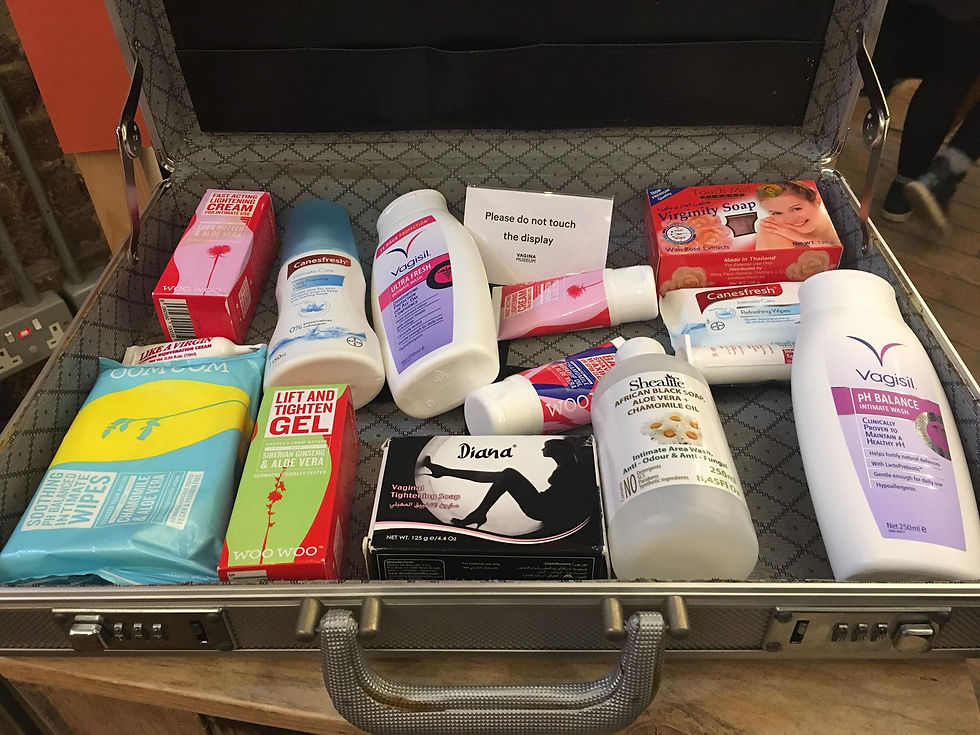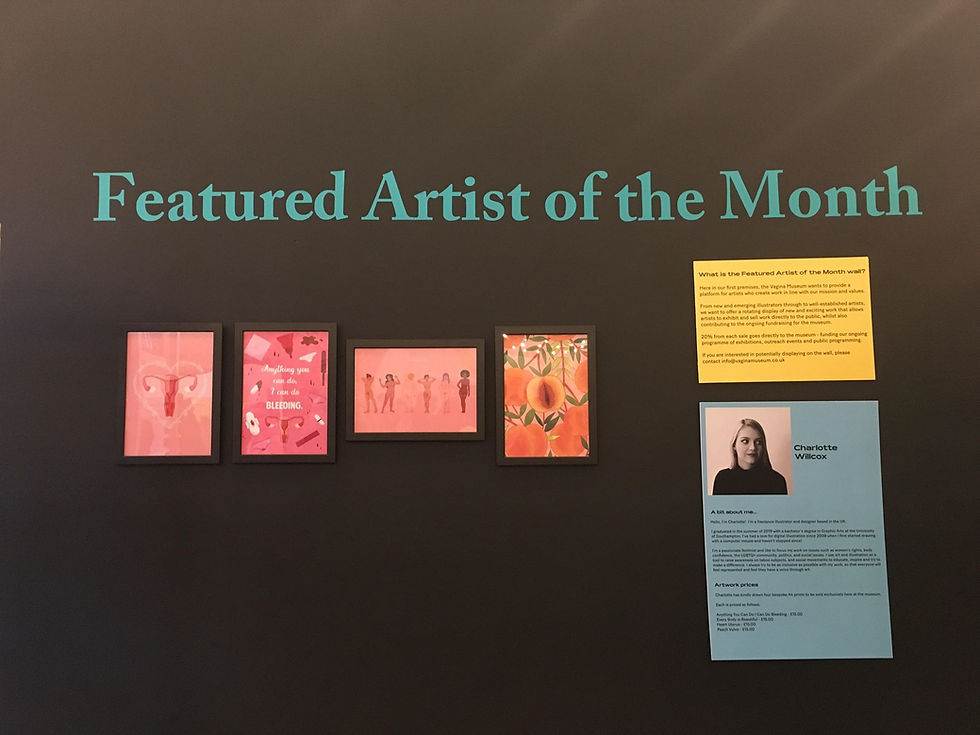The exhibition busting myths about anatomy and sexuality
- The Gallyry

- Dec 1, 2019
- 4 min read
Updated: Jan 11, 2020
Confused about the vagina? Baffled by the vulva? Can’t find the clitoris? Don’t worry – a new Vagina Museum is here to help
By Flora Doble
Cum one, cum all! After a series of successful pop-up events across the c(o)untry and an international crowdfunding campaign that raised over £50,000, the Vagina Museum has opened its first permanent location in Camden Market!
Free to enter (*ahem*) seven days a week, the Vagina Museum is the brainchild of science communicator Florence Schechter and is dedicated to the destigmatisation of vulvas, vaginas, and gynaecological anatomy. The museum’s first exhibition Muff Busters: Vagina Myths and How to Fight Them opened to the public on 16th November and saw an impressive 2,000 visitors on its first day.
Even though just under half of the world’s population have a vagina, ‘down there’ remains a taboo topic. There is a Penis Museum in Iceland and a Sex Museum in Amsterdam (where else?) but a Vagina Museum has seemed, for a long while, unthinkable. There is an astounding lack of information available online, in schools or even in medical textbooks about the gynaecological anatomy, and sex education repeatedly focuses on the penis, while representing women and their ‘front bottoms’ as nothing more than a receptacle for male sexuality.
When female sexuality is acknowledged, it has traditionally been presented as a dangerous thing that needs to be controlled. The folk tale of the castrating vagina dentata (toothed vagina) can be found in Hindu and Maori lore and the ancient Greek myth of Medusa that warms against the power of the sexually liberated woman are just two examples of this. Violence, the legal system, and societal pressure are routinely used to subjugate women and those with vaginas to maintain the patriarchal hierarchy.
Muff Busters tackles a plethora of issues including sex, puberty, and gender identity. The myths busted are displayed on large illustrated panels and cover ‘dirty’ vaginas, faux contraceptive methods, whether sex makes your vagina looser (spoiler: it doesn’t) and much more.
Society’s demure attitude towards gynaecological anatomy is proven to be linked to health complications, low self-esteem and even death. The exhibition presents some shocking statistics that clearly demonstrate the dangerous and upsetting repercussions of the lack of education on such issues.
Between 2002 and 2012, labiaplasty (cosmetic surgery on the labia) increased by 500% on the NHS alone
26.7% of women aged 25-29 are too embarrassed to attend cervical screenings
1 in 4 girls did not learn about periods before they had them
The star of the exhibition is undoubtedly a giant tampon covered in red sequins created by artist Sam Darwood. Visitors can also view a box of ludicrous and unnecessary feminine hygiene products – such as virginity soap, vagina lift and tightening gel, as well as an Indian science textbook that presents the hymen as a valid way of determining whether someone is a virgin. Female sexuality has been and is frequently commodified and given a measurable value to undermine and control people with vaginas.

Importantly, the Vagina Museum is committed to intersectionality (which it puts as one of its core values) and makes sure to use inclusive language throughout the exhibition. There is one board that addresses the false idea that one needs a vagina to be a woman and highlights the experiences of intersex, non-binary, and transgender individuals. As an appreciated extra touch, the lanyards of all staff and volunteers include their personal pronouns.
There are topics covered in Muff Busters that I have never seen discussed elsewhere. It is fantastic that information about vaginal discharge (a natural process, by the way!) is included which actually answered a question from a friend that had stumped me. Vagina connoisseur or not, you will no doubt learn something new at the Vagina Museum. Though the exhibition is small, it is extensive in its topics and an invaluable resource for any visitor.
If Muff Busters isn’t enough, the Vagina Museum also boasts an impressive line-up of events including Bajingo Bingo, pub(e) quizzes, talks, plays, and a monthly book club brilliant titled Cliterature. There is a small online and physical shop with all sorts of fannytastic products, from unique pussy pendants designed by artist Denise Rosenboom to a clitoris cross-stitch pattern. A featured ‘Artist of the Month’ wall in the museum will display artists who create work in line with the museum’s values. Charlotte Wilcox is the first artist to be featured, who generously supplied images seen throughout the exhibition and designed postcards and prints for the shop.

A visit to the Vagina Museum is not only an educational day out, but it is fun too. From the gift shop to a slick website, puns are to be found everywhere. This is in fact one of the museum’s greatest strengths. In anticipating the jokes that may be used to belittle it – “You should put a Penis Museum inside the Vagina Museum!” being a popular one – the museum is able to embrace the silliness of talking about genitalia and sex before then pushing this aside to concentrate on the important stuff.
It is incredible to see a Vagina Museum with such a wealth of information open to such a warm reception, but it is also a poignant reminder of how far society still has to go. Basic anatomical facts remain unknown and many individuals are still mystified by their own bodies. To learn that the ovaries are merely the size of an almond (the diagrams are never to scale!) or that the clitoris is much more than the external glans is just the start of this new sexual revolution. The Vagina Museum and its first exhibition Muff Busters will hopefully help facilitate important conversations that will not only educate but also save embarrassment, distress, and even lives.








Comments